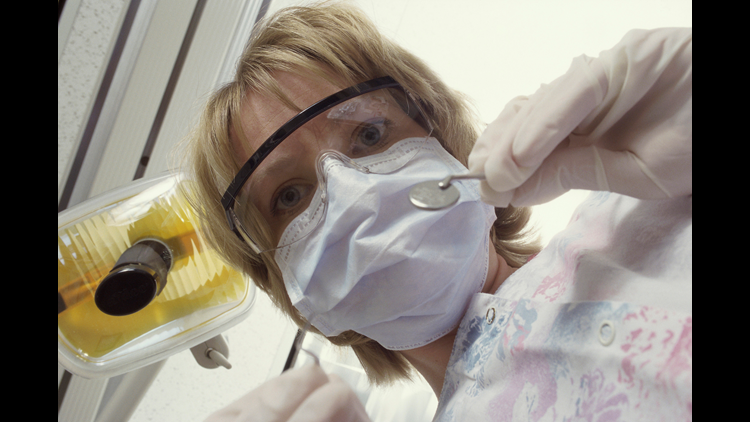The sight of sharp dental picks and forceps. The bad memories of bleeding gums. The exquisite agony of a root canal. All of it can cause anxiety among the boldest dental patient.
Another major source of anxiety is the price of those dental visits, from routine cleanings to extensive procedures. More than 40 percent of adults said they don’t visit the dentist because of the cost, according to a 2014 study by the American Dental Association (ADA) Health Policy Institute. And 21.9 percent of high-income adults with insurance still cited cost as a reason for missing visits.
At the end of the day, most dentists are in the business of helping people achieve great oral health, and there’s nothing better than finding a dentist you can trust 100%. But it’s still vital to understand why a dentist is taking X-rays, recommending certain procedures or handling billing in certain ways. Equally vital is having confidence that those explanations are in your best interest.
“Most dentists are honest and ethical, but a disturbing minority are willing to jeopardize their own licenses and their patients’ care to pursue insurance money illegally,” says James Quiggle, director of communications for the Washington D.C.-based Coalition Against Insurance Fraud.
Avoid unnecessary procedures and bill padding by recognizing these five lies your dentist might tell you.
1. “We can’t give you an estimate of the cost.”
Any dentist’s office should be able to get you an estimate of the cost, or at least help you get that information from your insurer.
“Ask your dentist to pre-estimate the costs of treatment before the procedure is done, and compare that to what other dentists show you,” Quiggle says. “You might find a difference in price or how much work needs to be done, if it needs to be done at all.”
Prices vary widely across the nation. The national average cost of a root canal stands at $415-$1,575, according to the ADA. The survey was based on 1,695 respondents.
The ADA further notes that many variables will affect the actual treatment cost ± consider, for instance, the types of materials used or the size of the treatment area. Online cost estimators and calculators, such as Delta Dental’s cost estimator, can give costs for specific cities.
“Patients need to be far more assertive in understanding the procedures and their detailed dental bills. Patients also should know what procedures are needed and which ones aren’t needed,” Quiggle says.
2. “You need multiple tooth extractions or root canals.”
Unless you absolutely abuse and neglect your teeth, multiple major procedures shouldn’t pop out of nowhere at the dentist’s office. While root canals and tooth extractions can sneak up on some patients, most of the time there’s significant pain associated with them beforehand.
No matter what’s being recommended, ask your dentist why you need a procedure, says Dr. Daniel Croley, vice president of network development for Delta Dental, a national dental benefits carrier based in Oak Brook, Ill.
Quiggle adds, “If a dentist recommends elaborate and invasive procedures such as multiple root canals or extractions or multiple cavity fillings, get a second or third opinion.”
A dentist could tack unneeded procedures onto a legitimate one. If you only have a cavity, there’s no need to have a root canal in addition to a filling. There should be proof that a root canal is necessary.
“You may need some cavity drilling, but suddenly the dentist is recommending several tooth extractions or root canals even though your mouth in general feels pretty good and you haven’t found any sign that your mouth is in that sad of shape,” Quiggle says. “That should be a red flag.”
3. “We need to replace all your silver fillings.”
There is a risk of metal poisoning with an amalgam filling, which contains heavy metals that aren’t healthy when exposed. However, that’s the keyword: exposed.
The Food and Drug Administration (FDA) finds that amalgam is a safe filling material. Amalgam fillings are bound, keeping any potentially harmful metals contained. Replacement with a white filling is only needed if the silver one is compromised.
“Replacing amalgams, which if you have metal allergies and things like that, it is definitely warranted,” Croley says. “But it isn’t warranted in every situation if the filling is still in good shape, meaning the margins are still clean.”
The other important factor is the number of fillings being recommended for replacement. If one filling is compromised, that doesn’t inherently mean that your others are, too. They might need to replaced eventually, but they might not present any medical risks for decades. If a dentist recommends that 10 fillings be replaced all at once, think second opinion or visual evidence.
4. “We need to do another X-ray.”
While patients should have a set of X-rays on file, Croley says they’re only necessary every year or two for the average dental patient. They shouldn’t be used to detect diseases without a warning sign.
ADA guidelines state, “Radiographic screening for the purpose of detecting disease before clinical examination should not be performed.”
Patients should be exposed to no more radiation than what’s necessary to adequately diagnose the condition of the mouth, Croley says.
5. “We need to split up your charges to make billing easier.”
Complicated dental procedures often require dental offices to use various individual medical billing codes, which collectively make up that procedure. But you shouldn’t be billed for all the individual codes — only the overall procedure.
“Maybe you should be billed for a full comprehensive procedure, such as a root canal, but the dentist breaks it down into single codes that actually should be bundled into one procedure,” Quiggle says. “All the single codes add up to way more money than just the single procedure would.”
Individual codes for a root canal would include applying anaesthetic, making the incision into the tooth’s crown and filling the root canals, along with the temporary crown, which is applied afterward. Only the root canal, not those other charges, should end up on your bill.
6. “You need a deep cleaning.”
A deep cleaning may sound like marketing mumbo jumbo, but it’s actually a medical procedure that fights specific diseases, including gingivitis. It’s a much more rigorous tooth cleaning that focuses on the space between tooth and gums.
“If you have a disease process started, sometimes you need to go in between the tooth and the gums and clean in between that area and make sure all the bacteria and all the plaque, calculus, or tartar is removed and heal back to normal,” Croley says.
Since most people don’t realize the circumstances in which a deep cleaning is useful, it can easily be upsold as a cosmetic enhancement cleaning, which is inaccurate. A standard prophylaxis, or dental cleaning, should suffice.
“If anyone recommends that you need periodontal cleaning, there should be evidence of that disease process that the dentist should be able to point out to you as the reason for why you need that deep cleaning,” Croley says.
The national average for a cleaning by a periodontist is $90-$175, according to the ADA Health Policy Institute’s 2016 fee survey.
Tips for protecting your finances at the dentist:
- Use pretax-dollar accounts like an FSA. Flexible spending accounts (FSAs) can be filled with pretax dollars from your paycheck and used for a host of health-related purchases. Since dental work is notoriously expensive, you might want to beef up your FSA if you plan on having major work done. Get an estimate from your dentist so you know how much to budget for the procedure, because FSAs do come with contribution limits and not all contributions rollover each year.
- Don’t rush into cosmetic procedures. Beautifying operations or applications might be right for you. By that, we mean such things as whitening and dental veneers. But make sure to understand what your insurance benefits covers, and what it doesn’t.
- Chew over your bill. Indeed, you should check your bill every time, just in case a phantom charge appears. They’re rare, but it’s better to be safe than sorry. “People have found that they’ve been billed while on vacation or were out of town, but here was this magical cavity filling while they were in France,” Quiggle says. “How did that happen?”
MagnifyMoney is a price comparison and financial education website, founded by former bankers who use their knowledge of how the system works to help you save money.



